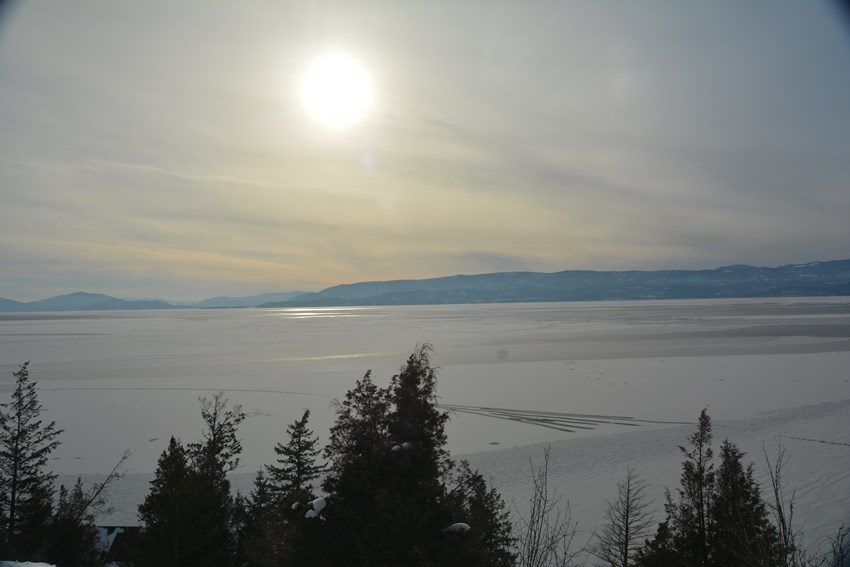Deep Dive into FLBS: The Story of the Flathead Lake Freeze
Written from the perspective of FLBS Media and Information Specialist Ian Withrow, each "Deep Dive into FLBS" column features entirely original content and provides a behind-the-scenes glimpse at Bio Station science, researchers, partners and programs. Stay tuned for future installments in upcoming editions of the Bigfork Eagle.
My wife loves reminding me that, more often than not, I have no idea what I’m talking about. I don’t disagree with her, because (as I love to remind her in return) admitting that I have no idea what I’m talking about is a fantastic way to guarantee that I’m never wrong. Thus, it is with the confidence of an undefeated arguer that I present the following thesis: From the spiritual to the secular, from fantasy to fact, when it comes to immersive storytelling there is no greater ingredient than a meteorological event.
Oh sure, character development and plot have their place at the table, and of course one must recognize the value of strong dialogue, diction, and so on. But for my money, whether serving as a thrilling atmosphere for the uncanny or the symbolic intersection of heartbreak and hope, nothing is more effective at igniting the imagination than a good old fashioned, once in a generation weather event.
Maybe I feel so strongly about this because I grew up in Montana, where my narratives revolve around such memorable events as the Devastating Drought of 1989, the Christmas Eve Blizzard of 1995, and the Torrential Flooding of 2010. These events burn like beacons, an assortment of Gatsby green lights that illuminate my familial bedtime stories, which I’m sure are quite similar to the stories many other Montana residents hold dear. This is the land of Maclean’s heat wave summers, after all, the bleak and ominous winters of Welch. Spend enough time in this state and you’ll find that your own personal stories are suddenly and deeply interwoven with whatever is going on outside your front door.
But among these climatic cornerstones of Montana lore, one seems to engage the interest of our local communities more than any other: The ever-elusive Flathead Lake Freeze.
A big reason for the fascination is the rarity of this event. The largest freshwater lake west of the Mississippi, Flathead lake occupies 200 square miles of real estate and reaches nearly 400 feet in depth. According to FLBS lake ecologist Jim Craft, for ice to develop across its entire surface, a series of conditions must be met.
First, the lake water must be very cold. The greatest opportunity for a Flathead Lake Freeze is in the early spring, when the lake has had a full winter of icy weather to cool down. Then, there must be frigid air temperatures for an extended period, specifically ten days (or more) of air at minus-10 degrees or below. Next, the lake needs to be dead calm for ice to form on the open water. This often occurs after a strong cold front blows through, when windless subzero temperatures settle in. These cold, calm conditions allow ice from the bays to build out towards the middle of the lake.
Craft emphasizes that it’s this final stillness that plays the most important role in ice buildup. Even a slight wind ripple can prevent lake ice from forming. It’s no secret around here that even the slightest wind blowing in the right direction can bring rough, near-oceanic conditions to Flathead Lake.
In March of 2019, Flathead Lake came as close to freezing over as it had in 30 years. Prior to this, FLBS scientists documented that the lake reached 80% ice coverage in January 1997 and 90% ice coverage in March 1993. Each time, the return of wind gusts—followed by warmer temperatures—prevented the complete freeze from taking place.
So, when was the last time Flathead Lake completely froze over? If you dig into the annals of the FLBS Flathead Monitoring Program, you’ll find that historically the lake froze across roughly once each decade. However, the last time the lake froze entirely was in January of 1989, more than 30 years ago, when the lake was completely covered with ice for 51 consecutive days. Prior to that, from December of 1985 through March of 1986, the lake was frozen for an unfathomable 79 consecutive days.
It's this latter event that resides in my memory as the Flathead Lake Freeze of 1986. This was the same year my mom and I stopped off at the 4B’s Restaurant in Polson on our way north to visit family in Whitefish, and I remember sitting in a cozy corner booth, gazing out at an ice-covered Polson Bay over mugs hot cocoa and bowls of tomato soup.
I was only three years old at the time, but that memory—one of my earliest—holds strong. I can still feel the steam of the tomato soup on my face, the sweet consistency of the hot cocoa’s whipped cream melting on my tongue. The clattering of silverware. The kind smile of the waitress. The postcard of a cartoon sea monster in the rack by the register, the one with, “Greetings from the Flathead Lake Monster” spelled out in looping letters across the top.
The full spectrum of the experience comes back to me in an instant, and in its wake, the memories string together until a story—my story—begins to emerge. It’s not a remarkable memory, but my emotions are stirred by the significant weather event. And when I look out at Flathead Lake today and see the ice gathering and receding along the shorelines of Polson Bay, I can’t help but recall the stories of my past and wish for a magical Flathead Lake Freeze to someday happen again. For myself. For my children. For the mystical legacy of this remarkable lake and the rich narrative traditions of our Last, Best Place.


